Integrated Nursing Practice: Case Study of a COPD Patient in Hospital
VerifiedAdded on 2020/05/28
|8
|2072
|106
Case Study
AI Summary
This assignment presents a detailed case study of a 68-year-old male patient, Jim Cooper, admitted to the respiratory medical unit with a history of COPD, productive cough, and shortness of breath. The case study outlines the patient's medical history, vital signs, and presenting symptoms, including impaired social interaction and potential alcohol withdrawal. The assignment prioritizes health issues such as compromised airway clearance, potential for hypoxia, and impaired social interaction, explaining the rationale for each ranking. It further explores the nurses' roles in addressing these prioritized health issues, including diagnosis, airway management, exercise, nutrition, and prevention of exacerbations. The assignment emphasizes the importance of nurses in providing comprehensive care, including medication administration, oxygen therapy, and patient education to improve the patient's quality of life.
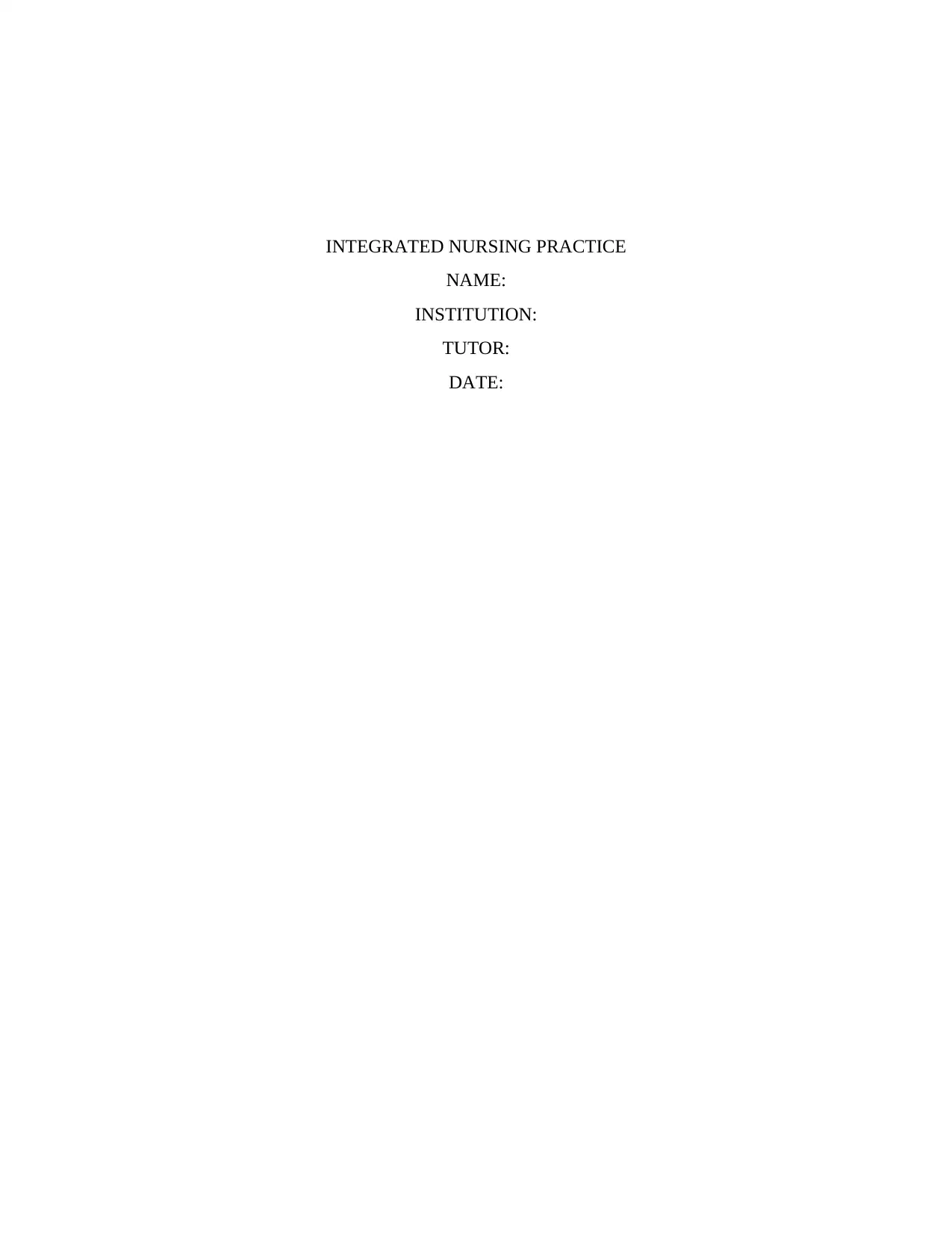
INTEGRATED NURSING PRACTICE
NAME:
INSTITUTION:
TUTOR:
DATE:
NAME:
INSTITUTION:
TUTOR:
DATE:
Paraphrase This Document
Need a fresh take? Get an instant paraphrase of this document with our AI Paraphraser
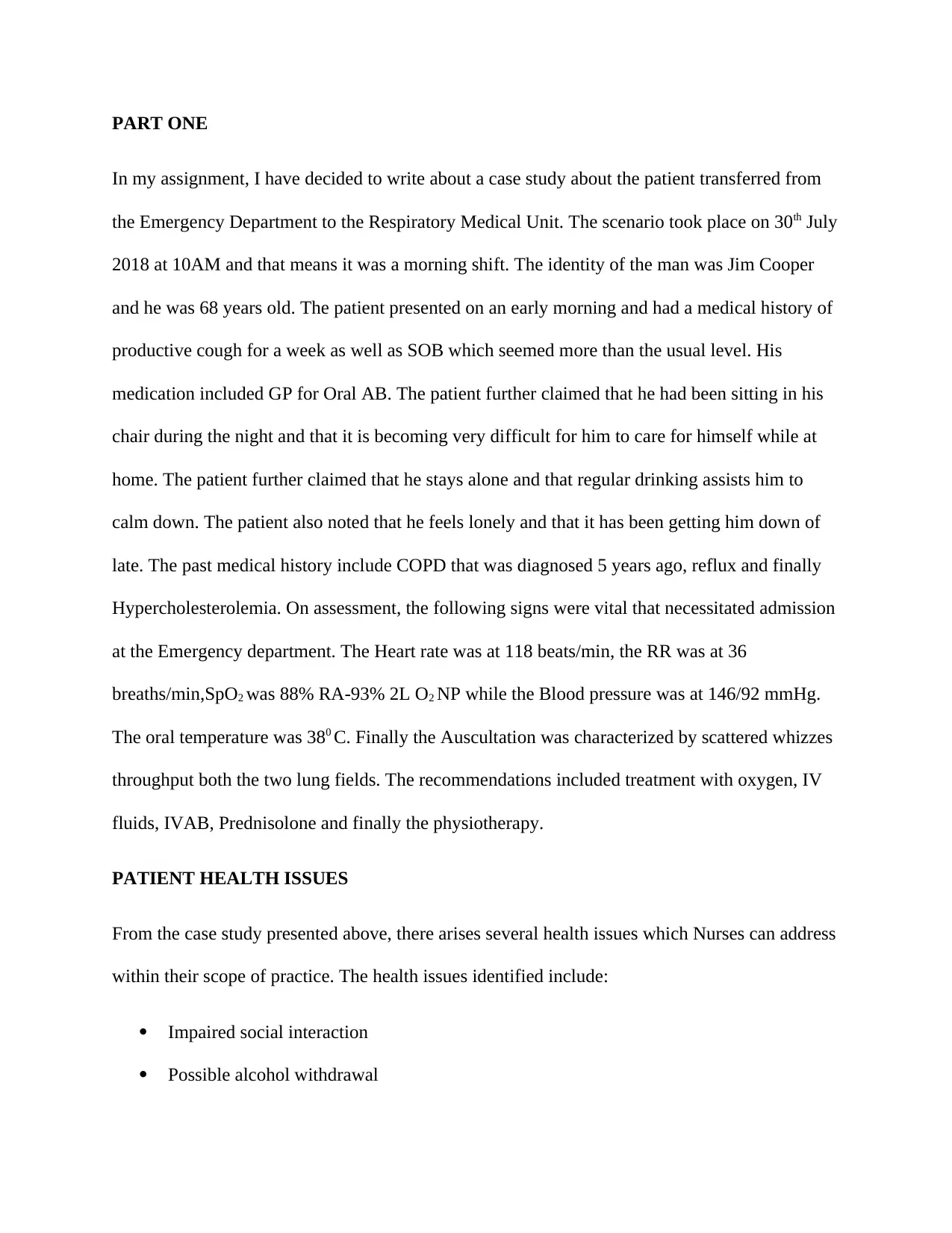
PART ONE
In my assignment, I have decided to write about a case study about the patient transferred from
the Emergency Department to the Respiratory Medical Unit. The scenario took place on 30th July
2018 at 10AM and that means it was a morning shift. The identity of the man was Jim Cooper
and he was 68 years old. The patient presented on an early morning and had a medical history of
productive cough for a week as well as SOB which seemed more than the usual level. His
medication included GP for Oral AB. The patient further claimed that he had been sitting in his
chair during the night and that it is becoming very difficult for him to care for himself while at
home. The patient further claimed that he stays alone and that regular drinking assists him to
calm down. The patient also noted that he feels lonely and that it has been getting him down of
late. The past medical history include COPD that was diagnosed 5 years ago, reflux and finally
Hypercholesterolemia. On assessment, the following signs were vital that necessitated admission
at the Emergency department. The Heart rate was at 118 beats/min, the RR was at 36
breaths/min,SpO2 was 88% RA-93% 2L O2 NP while the Blood pressure was at 146/92 mmHg.
The oral temperature was 380 C. Finally the Auscultation was characterized by scattered whizzes
throughput both the two lung fields. The recommendations included treatment with oxygen, IV
fluids, IVAB, Prednisolone and finally the physiotherapy.
PATIENT HEALTH ISSUES
From the case study presented above, there arises several health issues which Nurses can address
within their scope of practice. The health issues identified include:
Impaired social interaction
Possible alcohol withdrawal
In my assignment, I have decided to write about a case study about the patient transferred from
the Emergency Department to the Respiratory Medical Unit. The scenario took place on 30th July
2018 at 10AM and that means it was a morning shift. The identity of the man was Jim Cooper
and he was 68 years old. The patient presented on an early morning and had a medical history of
productive cough for a week as well as SOB which seemed more than the usual level. His
medication included GP for Oral AB. The patient further claimed that he had been sitting in his
chair during the night and that it is becoming very difficult for him to care for himself while at
home. The patient further claimed that he stays alone and that regular drinking assists him to
calm down. The patient also noted that he feels lonely and that it has been getting him down of
late. The past medical history include COPD that was diagnosed 5 years ago, reflux and finally
Hypercholesterolemia. On assessment, the following signs were vital that necessitated admission
at the Emergency department. The Heart rate was at 118 beats/min, the RR was at 36
breaths/min,SpO2 was 88% RA-93% 2L O2 NP while the Blood pressure was at 146/92 mmHg.
The oral temperature was 380 C. Finally the Auscultation was characterized by scattered whizzes
throughput both the two lung fields. The recommendations included treatment with oxygen, IV
fluids, IVAB, Prednisolone and finally the physiotherapy.
PATIENT HEALTH ISSUES
From the case study presented above, there arises several health issues which Nurses can address
within their scope of practice. The health issues identified include:
Impaired social interaction
Possible alcohol withdrawal
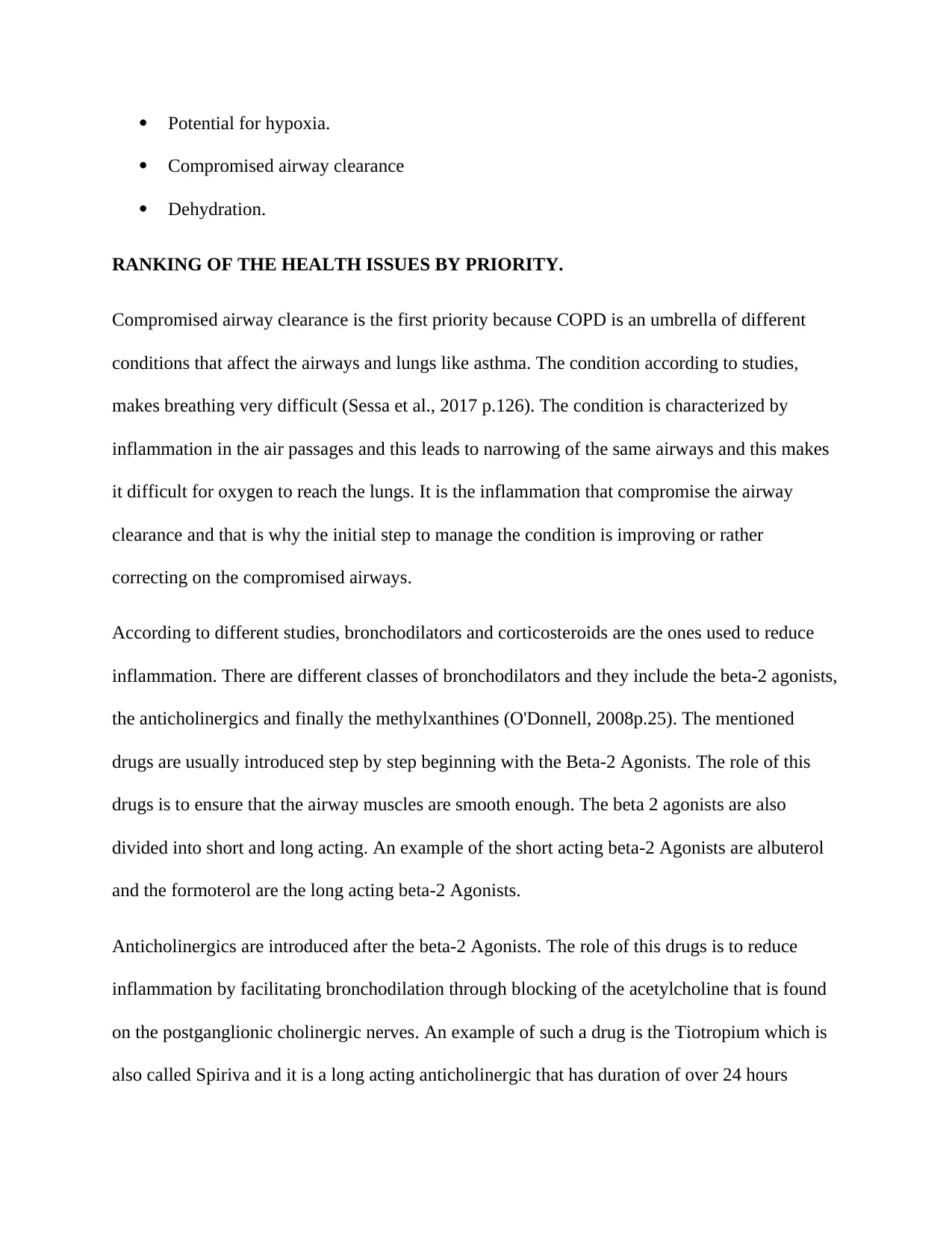
Potential for hypoxia.
Compromised airway clearance
Dehydration.
RANKING OF THE HEALTH ISSUES BY PRIORITY.
Compromised airway clearance is the first priority because COPD is an umbrella of different
conditions that affect the airways and lungs like asthma. The condition according to studies,
makes breathing very difficult (Sessa et al., 2017 p.126). The condition is characterized by
inflammation in the air passages and this leads to narrowing of the same airways and this makes
it difficult for oxygen to reach the lungs. It is the inflammation that compromise the airway
clearance and that is why the initial step to manage the condition is improving or rather
correcting on the compromised airways.
According to different studies, bronchodilators and corticosteroids are the ones used to reduce
inflammation. There are different classes of bronchodilators and they include the beta-2 agonists,
the anticholinergics and finally the methylxanthines (O'Donnell, 2008p.25). The mentioned
drugs are usually introduced step by step beginning with the Beta-2 Agonists. The role of this
drugs is to ensure that the airway muscles are smooth enough. The beta 2 agonists are also
divided into short and long acting. An example of the short acting beta-2 Agonists are albuterol
and the formoterol are the long acting beta-2 Agonists.
Anticholinergics are introduced after the beta-2 Agonists. The role of this drugs is to reduce
inflammation by facilitating bronchodilation through blocking of the acetylcholine that is found
on the postganglionic cholinergic nerves. An example of such a drug is the Tiotropium which is
also called Spiriva and it is a long acting anticholinergic that has duration of over 24 hours
Compromised airway clearance
Dehydration.
RANKING OF THE HEALTH ISSUES BY PRIORITY.
Compromised airway clearance is the first priority because COPD is an umbrella of different
conditions that affect the airways and lungs like asthma. The condition according to studies,
makes breathing very difficult (Sessa et al., 2017 p.126). The condition is characterized by
inflammation in the air passages and this leads to narrowing of the same airways and this makes
it difficult for oxygen to reach the lungs. It is the inflammation that compromise the airway
clearance and that is why the initial step to manage the condition is improving or rather
correcting on the compromised airways.
According to different studies, bronchodilators and corticosteroids are the ones used to reduce
inflammation. There are different classes of bronchodilators and they include the beta-2 agonists,
the anticholinergics and finally the methylxanthines (O'Donnell, 2008p.25). The mentioned
drugs are usually introduced step by step beginning with the Beta-2 Agonists. The role of this
drugs is to ensure that the airway muscles are smooth enough. The beta 2 agonists are also
divided into short and long acting. An example of the short acting beta-2 Agonists are albuterol
and the formoterol are the long acting beta-2 Agonists.
Anticholinergics are introduced after the beta-2 Agonists. The role of this drugs is to reduce
inflammation by facilitating bronchodilation through blocking of the acetylcholine that is found
on the postganglionic cholinergic nerves. An example of such a drug is the Tiotropium which is
also called Spiriva and it is a long acting anticholinergic that has duration of over 24 hours
⊘ This is a preview!⊘
Do you want full access?
Subscribe today to unlock all pages.

Trusted by 1+ million students worldwide
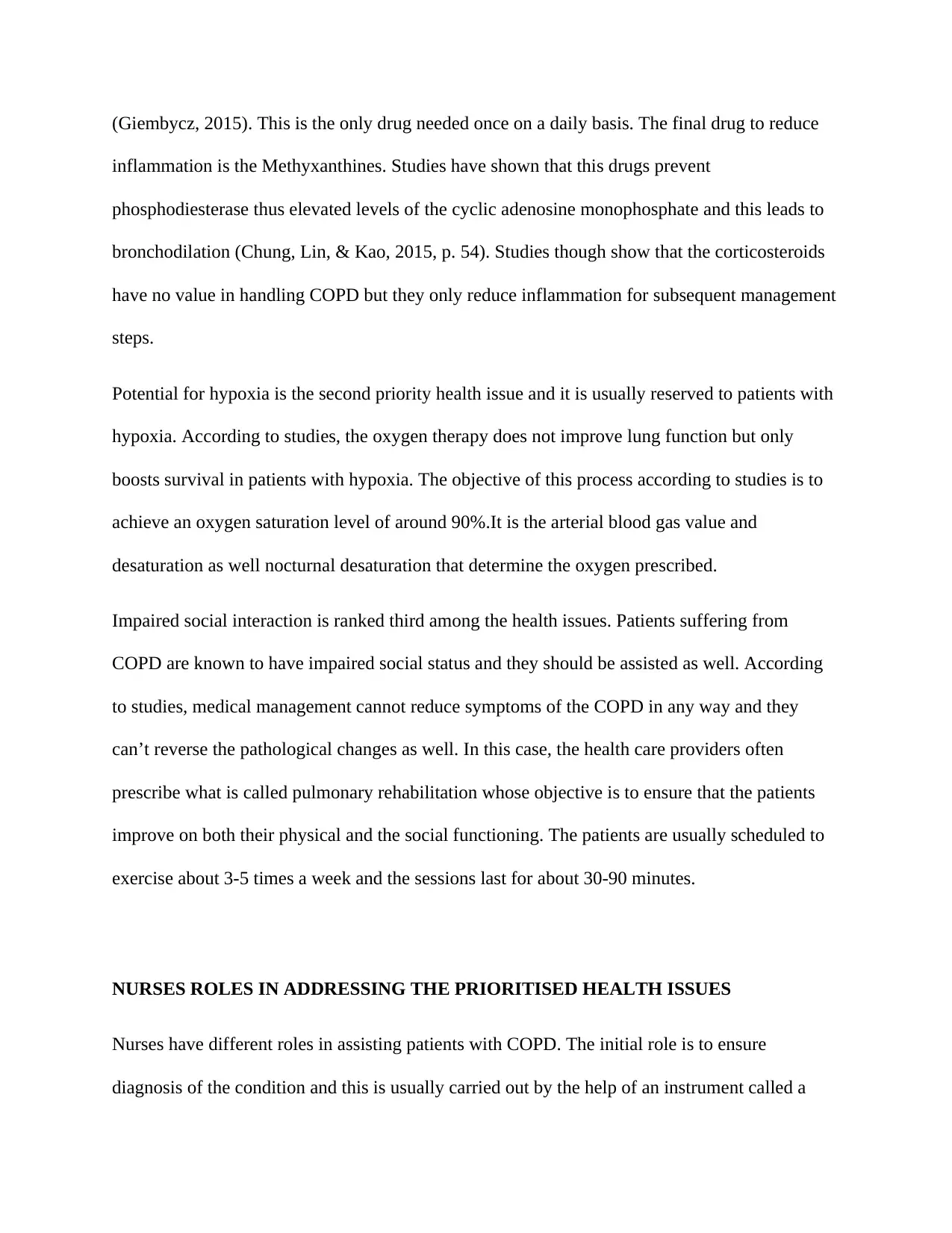
(Giembycz, 2015). This is the only drug needed once on a daily basis. The final drug to reduce
inflammation is the Methyxanthines. Studies have shown that this drugs prevent
phosphodiesterase thus elevated levels of the cyclic adenosine monophosphate and this leads to
bronchodilation (Chung, Lin, & Kao, 2015, p. 54). Studies though show that the corticosteroids
have no value in handling COPD but they only reduce inflammation for subsequent management
steps.
Potential for hypoxia is the second priority health issue and it is usually reserved to patients with
hypoxia. According to studies, the oxygen therapy does not improve lung function but only
boosts survival in patients with hypoxia. The objective of this process according to studies is to
achieve an oxygen saturation level of around 90%.It is the arterial blood gas value and
desaturation as well nocturnal desaturation that determine the oxygen prescribed.
Impaired social interaction is ranked third among the health issues. Patients suffering from
COPD are known to have impaired social status and they should be assisted as well. According
to studies, medical management cannot reduce symptoms of the COPD in any way and they
can’t reverse the pathological changes as well. In this case, the health care providers often
prescribe what is called pulmonary rehabilitation whose objective is to ensure that the patients
improve on both their physical and the social functioning. The patients are usually scheduled to
exercise about 3-5 times a week and the sessions last for about 30-90 minutes.
NURSES ROLES IN ADDRESSING THE PRIORITISED HEALTH ISSUES
Nurses have different roles in assisting patients with COPD. The initial role is to ensure
diagnosis of the condition and this is usually carried out by the help of an instrument called a
inflammation is the Methyxanthines. Studies have shown that this drugs prevent
phosphodiesterase thus elevated levels of the cyclic adenosine monophosphate and this leads to
bronchodilation (Chung, Lin, & Kao, 2015, p. 54). Studies though show that the corticosteroids
have no value in handling COPD but they only reduce inflammation for subsequent management
steps.
Potential for hypoxia is the second priority health issue and it is usually reserved to patients with
hypoxia. According to studies, the oxygen therapy does not improve lung function but only
boosts survival in patients with hypoxia. The objective of this process according to studies is to
achieve an oxygen saturation level of around 90%.It is the arterial blood gas value and
desaturation as well nocturnal desaturation that determine the oxygen prescribed.
Impaired social interaction is ranked third among the health issues. Patients suffering from
COPD are known to have impaired social status and they should be assisted as well. According
to studies, medical management cannot reduce symptoms of the COPD in any way and they
can’t reverse the pathological changes as well. In this case, the health care providers often
prescribe what is called pulmonary rehabilitation whose objective is to ensure that the patients
improve on both their physical and the social functioning. The patients are usually scheduled to
exercise about 3-5 times a week and the sessions last for about 30-90 minutes.
NURSES ROLES IN ADDRESSING THE PRIORITISED HEALTH ISSUES
Nurses have different roles in assisting patients with COPD. The initial role is to ensure
diagnosis of the condition and this is usually carried out by the help of an instrument called a
Paraphrase This Document
Need a fresh take? Get an instant paraphrase of this document with our AI Paraphraser
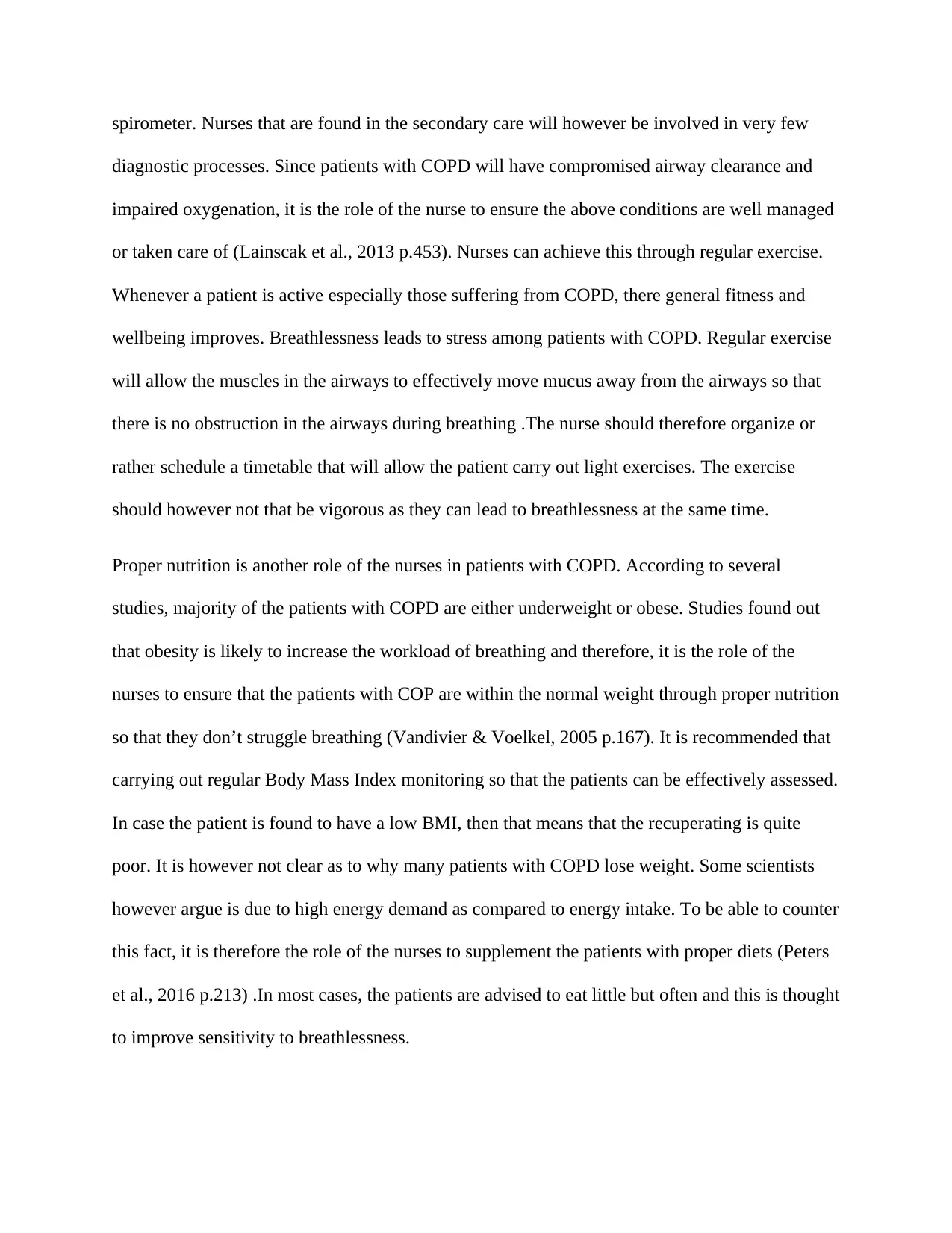
spirometer. Nurses that are found in the secondary care will however be involved in very few
diagnostic processes. Since patients with COPD will have compromised airway clearance and
impaired oxygenation, it is the role of the nurse to ensure the above conditions are well managed
or taken care of (Lainscak et al., 2013 p.453). Nurses can achieve this through regular exercise.
Whenever a patient is active especially those suffering from COPD, there general fitness and
wellbeing improves. Breathlessness leads to stress among patients with COPD. Regular exercise
will allow the muscles in the airways to effectively move mucus away from the airways so that
there is no obstruction in the airways during breathing .The nurse should therefore organize or
rather schedule a timetable that will allow the patient carry out light exercises. The exercise
should however not that be vigorous as they can lead to breathlessness at the same time.
Proper nutrition is another role of the nurses in patients with COPD. According to several
studies, majority of the patients with COPD are either underweight or obese. Studies found out
that obesity is likely to increase the workload of breathing and therefore, it is the role of the
nurses to ensure that the patients with COP are within the normal weight through proper nutrition
so that they don’t struggle breathing (Vandivier & Voelkel, 2005 p.167). It is recommended that
carrying out regular Body Mass Index monitoring so that the patients can be effectively assessed.
In case the patient is found to have a low BMI, then that means that the recuperating is quite
poor. It is however not clear as to why many patients with COPD lose weight. Some scientists
however argue is due to high energy demand as compared to energy intake. To be able to counter
this fact, it is therefore the role of the nurses to supplement the patients with proper diets (Peters
et al., 2016 p.213) .In most cases, the patients are advised to eat little but often and this is thought
to improve sensitivity to breathlessness.
diagnostic processes. Since patients with COPD will have compromised airway clearance and
impaired oxygenation, it is the role of the nurse to ensure the above conditions are well managed
or taken care of (Lainscak et al., 2013 p.453). Nurses can achieve this through regular exercise.
Whenever a patient is active especially those suffering from COPD, there general fitness and
wellbeing improves. Breathlessness leads to stress among patients with COPD. Regular exercise
will allow the muscles in the airways to effectively move mucus away from the airways so that
there is no obstruction in the airways during breathing .The nurse should therefore organize or
rather schedule a timetable that will allow the patient carry out light exercises. The exercise
should however not that be vigorous as they can lead to breathlessness at the same time.
Proper nutrition is another role of the nurses in patients with COPD. According to several
studies, majority of the patients with COPD are either underweight or obese. Studies found out
that obesity is likely to increase the workload of breathing and therefore, it is the role of the
nurses to ensure that the patients with COP are within the normal weight through proper nutrition
so that they don’t struggle breathing (Vandivier & Voelkel, 2005 p.167). It is recommended that
carrying out regular Body Mass Index monitoring so that the patients can be effectively assessed.
In case the patient is found to have a low BMI, then that means that the recuperating is quite
poor. It is however not clear as to why many patients with COPD lose weight. Some scientists
however argue is due to high energy demand as compared to energy intake. To be able to counter
this fact, it is therefore the role of the nurses to supplement the patients with proper diets (Peters
et al., 2016 p.213) .In most cases, the patients are advised to eat little but often and this is thought
to improve sensitivity to breathlessness.
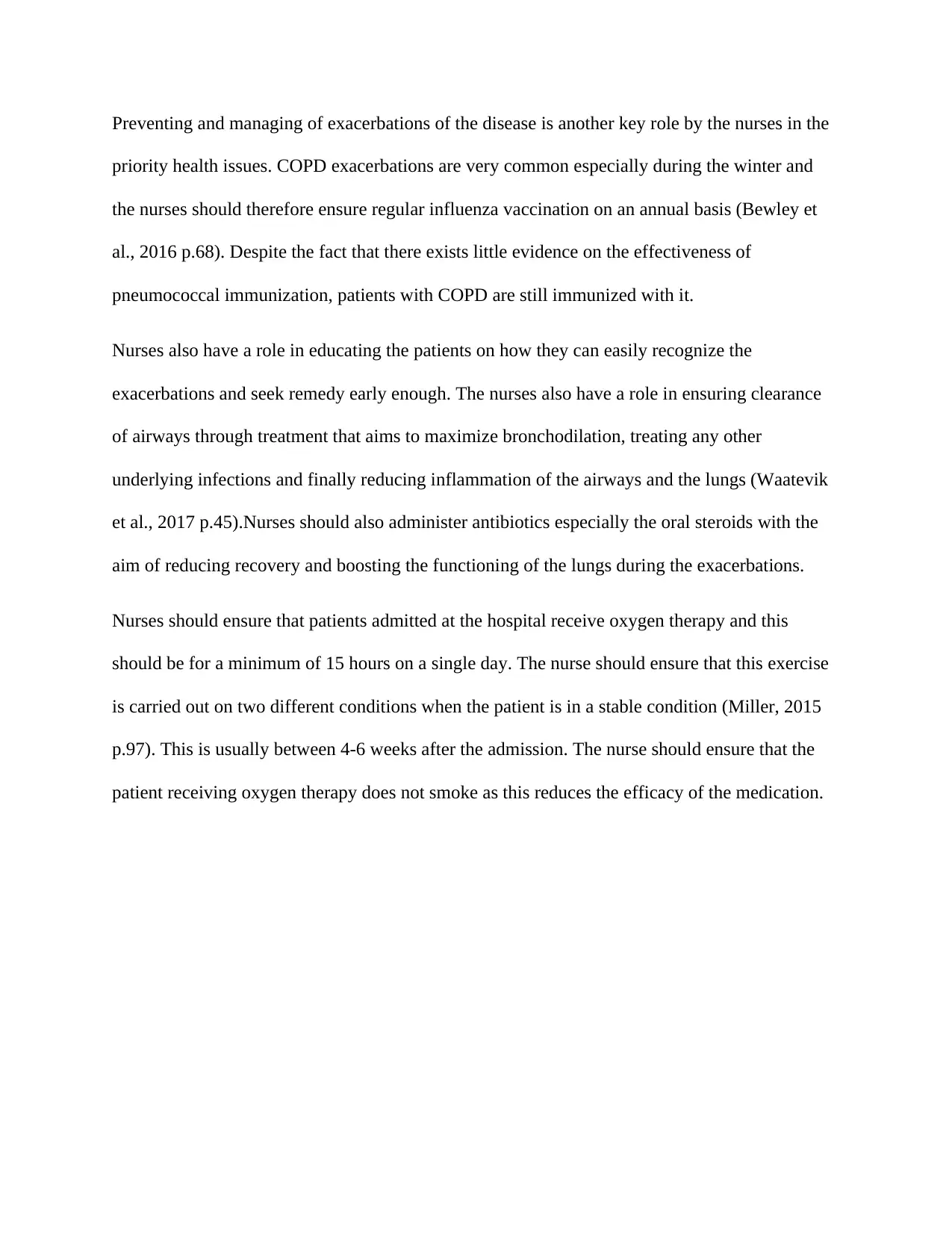
Preventing and managing of exacerbations of the disease is another key role by the nurses in the
priority health issues. COPD exacerbations are very common especially during the winter and
the nurses should therefore ensure regular influenza vaccination on an annual basis (Bewley et
al., 2016 p.68). Despite the fact that there exists little evidence on the effectiveness of
pneumococcal immunization, patients with COPD are still immunized with it.
Nurses also have a role in educating the patients on how they can easily recognize the
exacerbations and seek remedy early enough. The nurses also have a role in ensuring clearance
of airways through treatment that aims to maximize bronchodilation, treating any other
underlying infections and finally reducing inflammation of the airways and the lungs (Waatevik
et al., 2017 p.45).Nurses should also administer antibiotics especially the oral steroids with the
aim of reducing recovery and boosting the functioning of the lungs during the exacerbations.
Nurses should ensure that patients admitted at the hospital receive oxygen therapy and this
should be for a minimum of 15 hours on a single day. The nurse should ensure that this exercise
is carried out on two different conditions when the patient is in a stable condition (Miller, 2015
p.97). This is usually between 4-6 weeks after the admission. The nurse should ensure that the
patient receiving oxygen therapy does not smoke as this reduces the efficacy of the medication.
priority health issues. COPD exacerbations are very common especially during the winter and
the nurses should therefore ensure regular influenza vaccination on an annual basis (Bewley et
al., 2016 p.68). Despite the fact that there exists little evidence on the effectiveness of
pneumococcal immunization, patients with COPD are still immunized with it.
Nurses also have a role in educating the patients on how they can easily recognize the
exacerbations and seek remedy early enough. The nurses also have a role in ensuring clearance
of airways through treatment that aims to maximize bronchodilation, treating any other
underlying infections and finally reducing inflammation of the airways and the lungs (Waatevik
et al., 2017 p.45).Nurses should also administer antibiotics especially the oral steroids with the
aim of reducing recovery and boosting the functioning of the lungs during the exacerbations.
Nurses should ensure that patients admitted at the hospital receive oxygen therapy and this
should be for a minimum of 15 hours on a single day. The nurse should ensure that this exercise
is carried out on two different conditions when the patient is in a stable condition (Miller, 2015
p.97). This is usually between 4-6 weeks after the admission. The nurse should ensure that the
patient receiving oxygen therapy does not smoke as this reduces the efficacy of the medication.
⊘ This is a preview!⊘
Do you want full access?
Subscribe today to unlock all pages.

Trusted by 1+ million students worldwide
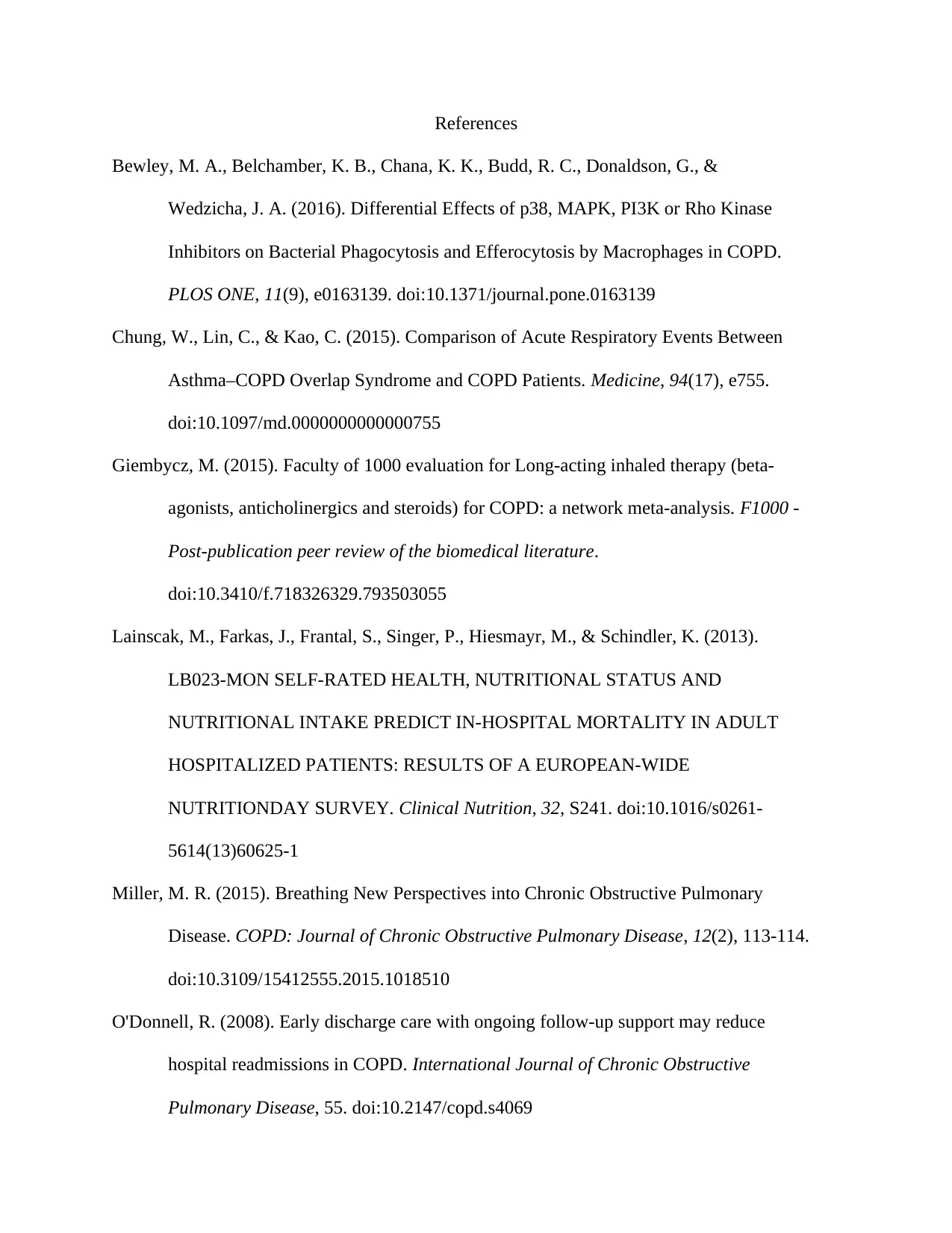
References
Bewley, M. A., Belchamber, K. B., Chana, K. K., Budd, R. C., Donaldson, G., &
Wedzicha, J. A. (2016). Differential Effects of p38, MAPK, PI3K or Rho Kinase
Inhibitors on Bacterial Phagocytosis and Efferocytosis by Macrophages in COPD.
PLOS ONE, 11(9), e0163139. doi:10.1371/journal.pone.0163139
Chung, W., Lin, C., & Kao, C. (2015). Comparison of Acute Respiratory Events Between
Asthma–COPD Overlap Syndrome and COPD Patients. Medicine, 94(17), e755.
doi:10.1097/md.0000000000000755
Giembycz, M. (2015). Faculty of 1000 evaluation for Long-acting inhaled therapy (beta-
agonists, anticholinergics and steroids) for COPD: a network meta-analysis. F1000 -
Post-publication peer review of the biomedical literature.
doi:10.3410/f.718326329.793503055
Lainscak, M., Farkas, J., Frantal, S., Singer, P., Hiesmayr, M., & Schindler, K. (2013).
LB023-MON SELF-RATED HEALTH, NUTRITIONAL STATUS AND
NUTRITIONAL INTAKE PREDICT IN-HOSPITAL MORTALITY IN ADULT
HOSPITALIZED PATIENTS: RESULTS OF A EUROPEAN-WIDE
NUTRITIONDAY SURVEY. Clinical Nutrition, 32, S241. doi:10.1016/s0261-
5614(13)60625-1
Miller, M. R. (2015). Breathing New Perspectives into Chronic Obstructive Pulmonary
Disease. COPD: Journal of Chronic Obstructive Pulmonary Disease, 12(2), 113-114.
doi:10.3109/15412555.2015.1018510
O'Donnell, R. (2008). Early discharge care with ongoing follow-up support may reduce
hospital readmissions in COPD. International Journal of Chronic Obstructive
Pulmonary Disease, 55. doi:10.2147/copd.s4069
Bewley, M. A., Belchamber, K. B., Chana, K. K., Budd, R. C., Donaldson, G., &
Wedzicha, J. A. (2016). Differential Effects of p38, MAPK, PI3K or Rho Kinase
Inhibitors on Bacterial Phagocytosis and Efferocytosis by Macrophages in COPD.
PLOS ONE, 11(9), e0163139. doi:10.1371/journal.pone.0163139
Chung, W., Lin, C., & Kao, C. (2015). Comparison of Acute Respiratory Events Between
Asthma–COPD Overlap Syndrome and COPD Patients. Medicine, 94(17), e755.
doi:10.1097/md.0000000000000755
Giembycz, M. (2015). Faculty of 1000 evaluation for Long-acting inhaled therapy (beta-
agonists, anticholinergics and steroids) for COPD: a network meta-analysis. F1000 -
Post-publication peer review of the biomedical literature.
doi:10.3410/f.718326329.793503055
Lainscak, M., Farkas, J., Frantal, S., Singer, P., Hiesmayr, M., & Schindler, K. (2013).
LB023-MON SELF-RATED HEALTH, NUTRITIONAL STATUS AND
NUTRITIONAL INTAKE PREDICT IN-HOSPITAL MORTALITY IN ADULT
HOSPITALIZED PATIENTS: RESULTS OF A EUROPEAN-WIDE
NUTRITIONDAY SURVEY. Clinical Nutrition, 32, S241. doi:10.1016/s0261-
5614(13)60625-1
Miller, M. R. (2015). Breathing New Perspectives into Chronic Obstructive Pulmonary
Disease. COPD: Journal of Chronic Obstructive Pulmonary Disease, 12(2), 113-114.
doi:10.3109/15412555.2015.1018510
O'Donnell, R. (2008). Early discharge care with ongoing follow-up support may reduce
hospital readmissions in COPD. International Journal of Chronic Obstructive
Pulmonary Disease, 55. doi:10.2147/copd.s4069
Paraphrase This Document
Need a fresh take? Get an instant paraphrase of this document with our AI Paraphraser
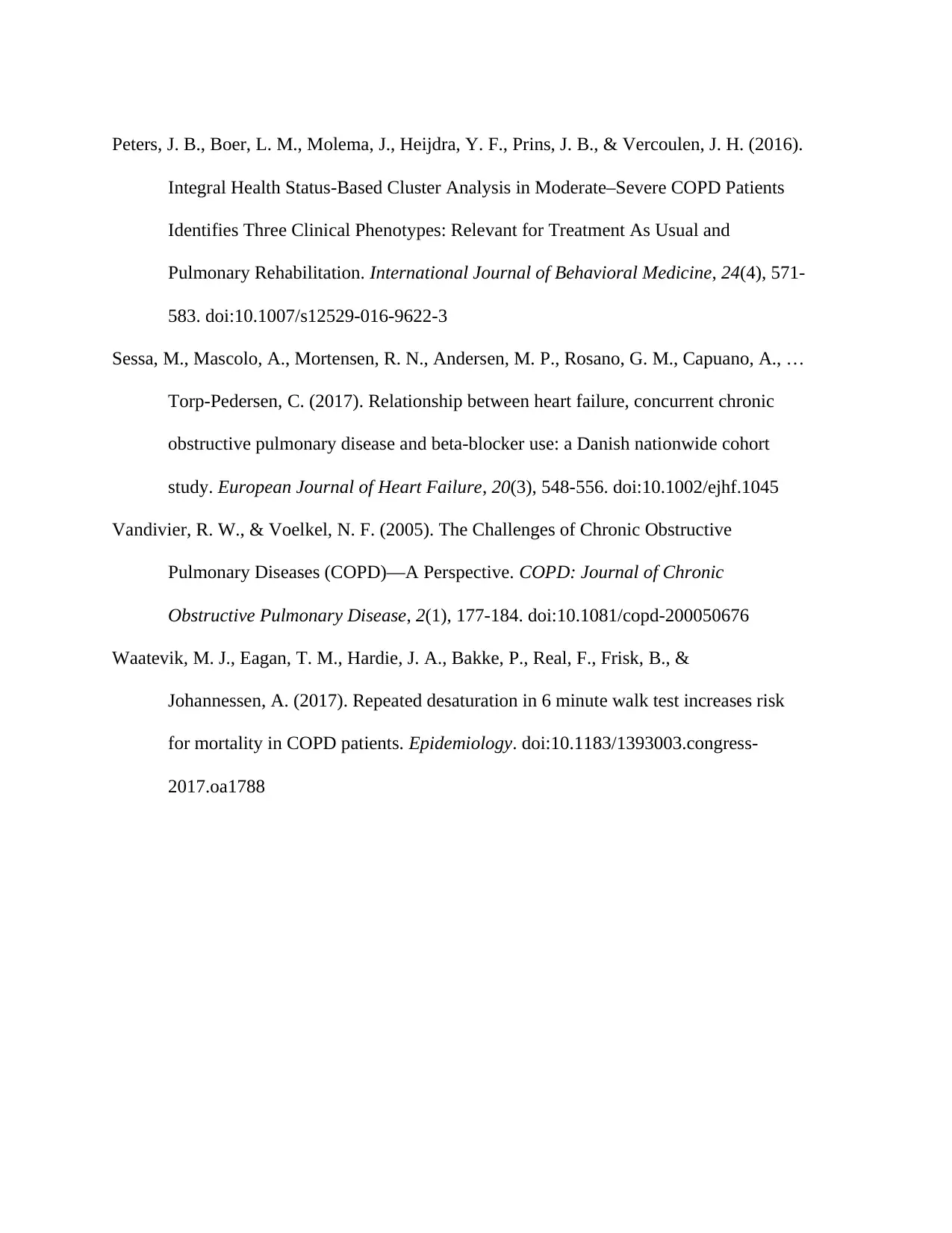
Peters, J. B., Boer, L. M., Molema, J., Heijdra, Y. F., Prins, J. B., & Vercoulen, J. H. (2016).
Integral Health Status-Based Cluster Analysis in Moderate–Severe COPD Patients
Identifies Three Clinical Phenotypes: Relevant for Treatment As Usual and
Pulmonary Rehabilitation. International Journal of Behavioral Medicine, 24(4), 571-
583. doi:10.1007/s12529-016-9622-3
Sessa, M., Mascolo, A., Mortensen, R. N., Andersen, M. P., Rosano, G. M., Capuano, A., …
Torp-Pedersen, C. (2017). Relationship between heart failure, concurrent chronic
obstructive pulmonary disease and beta-blocker use: a Danish nationwide cohort
study. European Journal of Heart Failure, 20(3), 548-556. doi:10.1002/ejhf.1045
Vandivier, R. W., & Voelkel, N. F. (2005). The Challenges of Chronic Obstructive
Pulmonary Diseases (COPD)—A Perspective. COPD: Journal of Chronic
Obstructive Pulmonary Disease, 2(1), 177-184. doi:10.1081/copd-200050676
Waatevik, M. J., Eagan, T. M., Hardie, J. A., Bakke, P., Real, F., Frisk, B., &
Johannessen, A. (2017). Repeated desaturation in 6 minute walk test increases risk
for mortality in COPD patients. Epidemiology. doi:10.1183/1393003.congress-
2017.oa1788
Integral Health Status-Based Cluster Analysis in Moderate–Severe COPD Patients
Identifies Three Clinical Phenotypes: Relevant for Treatment As Usual and
Pulmonary Rehabilitation. International Journal of Behavioral Medicine, 24(4), 571-
583. doi:10.1007/s12529-016-9622-3
Sessa, M., Mascolo, A., Mortensen, R. N., Andersen, M. P., Rosano, G. M., Capuano, A., …
Torp-Pedersen, C. (2017). Relationship between heart failure, concurrent chronic
obstructive pulmonary disease and beta-blocker use: a Danish nationwide cohort
study. European Journal of Heart Failure, 20(3), 548-556. doi:10.1002/ejhf.1045
Vandivier, R. W., & Voelkel, N. F. (2005). The Challenges of Chronic Obstructive
Pulmonary Diseases (COPD)—A Perspective. COPD: Journal of Chronic
Obstructive Pulmonary Disease, 2(1), 177-184. doi:10.1081/copd-200050676
Waatevik, M. J., Eagan, T. M., Hardie, J. A., Bakke, P., Real, F., Frisk, B., &
Johannessen, A. (2017). Repeated desaturation in 6 minute walk test increases risk
for mortality in COPD patients. Epidemiology. doi:10.1183/1393003.congress-
2017.oa1788
1 out of 8
Related Documents
Your All-in-One AI-Powered Toolkit for Academic Success.
+13062052269
info@desklib.com
Available 24*7 on WhatsApp / Email
![[object Object]](/_next/static/media/star-bottom.7253800d.svg)
Unlock your academic potential
Copyright © 2020–2025 A2Z Services. All Rights Reserved. Developed and managed by ZUCOL.





